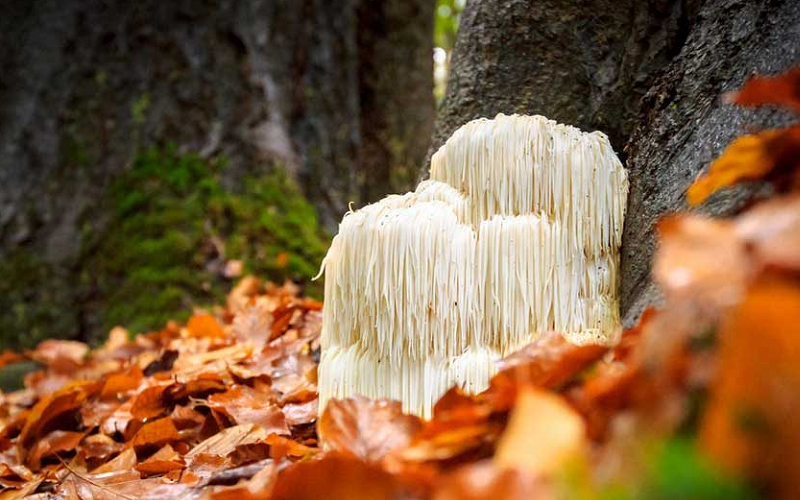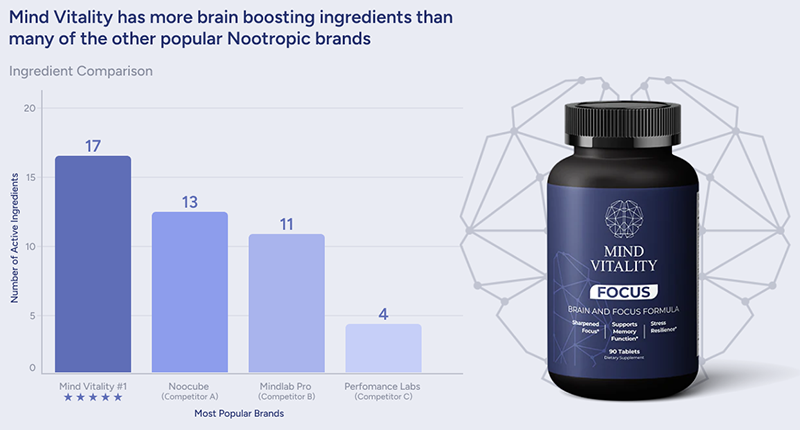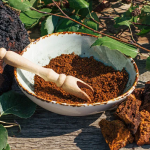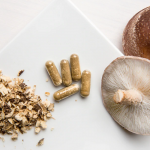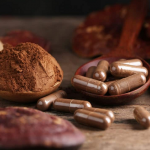Over the years — over the centuries in fact — several varieties of mushrooms have thought to have health and healing properties. Recently one species in particular has been receiving great attention: the lion’s mane mushroom.
This unusual looking mushroom has been found to have many health benefits, especially in the area of brain health and cognition improvement. Lion’s mane mushroom has been found to enhance memory, improve focus and clarity, and improve mood and lessen anxiety and depression.
Contents
What Is Lion’s Mane Mushroom?
The lion’s mane mushroom’s scientific, or botanical, name is Hericium erinaceus. In looking at the below picture of a large lion’s mane mushroom you can clearly see where the name lion’s mane comes from. It also goes by several other names related to its uncommon look, including old man’s beard, pom pom, and bearded tooth.
Unlike a typical mushroom, the lion’s mane doesn’t have a stem, or stalk, or a cap. Instead, it has many mostly white strands, or spines, that hang down from a single base. The purpose of the spines is to produce and release the spores that allow the fungus to reproduce.
Lion’s mane can be found in many places in the world, but it is most abundant in the south of the United States, Japan, China, and Europe. Its preferred place of growth is on dying or dead hardwood trees (such as walnut, oak and maple), or the logs and stumps of those trees.
While its popularity and appreciation as a brain-enhancer has came about only recently in the United States, lion’s mane mushroom has been used as an important herbal medicine in Traditional Chinese Medicine (TCM) for thousands of years.
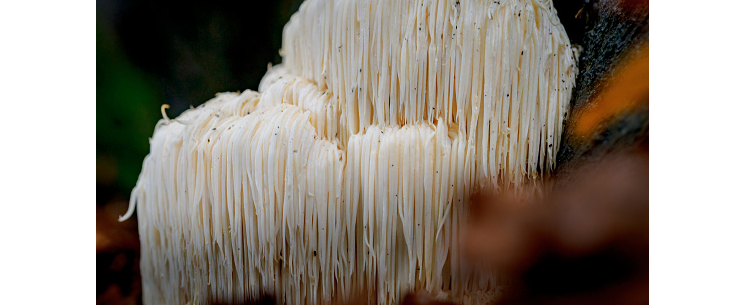
Lion’s Mane Mushrooms’ Nootropic Cognition Benefits
Nootropics, also referred to as cognitive enhancers, smart drugs, nutraceuticals, or neuroceuticals, are compounds that are known to improve brain function and enhance mental capabilities.
Some nootropics are prescription drugs, but many others are compounds derived from synthetic or natural sources and are available to anyone in the form of nutritional supplements. One such naturally-sourced nootropic is lion’s mane.
Lion’s Mane Increases Nerve Growth Factor (NGF) Levels
Nerve growth factor, or NGF, is a member of a family of biomolecules (molecules produced by living organisms) and plays a huge role in the growth and health of neurons — brain cells. Ensuring that your body releases sufficient levels of NGF is critical to your brain’s health. Lion’s mane mushroom is nature’s most powerful solution to stimulating increases in NGF levels in humans.
What Is Nerve Growth Factor (NGF)?
Nerve growth factor, or NGF, is a neurotrophin — a small family of protein-like molecules that secrete into the nervous system to keep neurons healthy.
NGF is vitally important because it is responsible for the maintenance, development and even regeneration of neurons (brain cells).
Researchers have concluded that NGF is essential for neuroplasticity (the brain’s ability reorganize synaptic connections in response to experience and learning) and learning.
The hippocampus is a small but significant component of the brain. While it’s usually referred to as “the hippocampus,” humans and other mammals actually have two hippocampi — there’s one located in each side of the brain. The hippocampus is so important because it acts as the control center for learning and memory. It’s within the hippocampus where the vast majority of brain cell growth occurs, and by increasing NGF levels activity in the hippocampus is optimized.
Lion’s Mane Stimulates NGF
Adequate levels of NGF are required to keep neurons alive, as well as to keep the whole nervous system in good health. It should be obvious by now that for humans, nerve growth factor is a pretty big deal! Lion’s mane too is a pretty big deal in that it has the ability to stimulate the release of NGF in the brain.
Lion’s mane can boost the release of NGF. If it’s possible for this simple mushroom to pull of such a trick, you would think that there are certainly many more herbs, plants, or fungi with the same abilities. However, that isn’t the case. The lion is king of the jungle, and the lion’s mane mushroom is the king of the NGF releasers. Why this is so has to do with the blood-brain barrier.
The blood-brain barrier (BBB) consists of tightly-packed cells that line the walls of the capillaries (very small blood vessels) that transport blood to the brain. The blood-brain barrier is a sort of filter that blocks any toxins present in the blood from entering brain cells. There are very few molecules small enough to get through the barrier (oxygen, essential to the brain, is one such compound that can pass through the barrier).
Compounds that have the ability to stimulate production of NGF in the brain need to be able to pass through the blood-brain barrier in order to carry out their work. Boosting NGF levels isn’t easy, as very few compounds have the ability to both be an NGF-releaser and small enough to breech the barrier. Lion’s mane has two such compounds — hericenones and erinacines.
Hericenones and erinacines are powerful NGF stimulators, have low molecular weights (allowing them to pass the BBB), and, interestingly, are known to exist only in this one particular mushroom. In fact, they derive their names from the scientific name of the mushroom itself — Hericium erinaceus. It is the compounds hericenones and erinacines that make lion’s mane such a powerful and popular nootropic.
Lion’s Mane Is a Powerful Anti-Inflammatory and Antioxidant
Inflammation plays a role in a host of negative health issues — including brain-related health concerns. An abundance of oxidants, or free radicals, are also responsible for health problems. In some cases there is a relationship between inflammation and oxidants. Lion’s mane is both an anti-inflammatory and an antioxidant, which is another reason (in addition to being an NGF-releaser) that this mushroom is considered to have nootropic powers.
Lion’s Mane Has Anti-Inflammatory Properties
Inflammation isn’t always a bad thing — there’s a reason your body’s immune system has the power to generate inflammatories. When your body is subject to harm, whether from toxins, infections, or injuries, it attempts to heal itself. One way it does this is by releasing chemicals that in turn force the immune system to react.
The reaction comes in the form of white blood cells sending out chemicals of their own, such as proteins and antibodies, that move to enter the bloodstream and then tissues in order to provide protection from the invaders, whatever form they might take. Blood flow to the affected area brings about warmth and redness, and possibly swelling.
Typically these side-effects of the immune system’s fight are negligible, but the immune system, like the entire body itself, is not a perfect system. Instead of lasting hours, or at most a few days, the response may linger for much longer. The result then is chronic inflammation — an immune response that causes excessive and ongoing activation of immune cells. Over time this constant — and no longer needed — attack of the body on itself has harmful effects on organs and tissues.
Here, lion’s mane comes to the rescue. Like shiitake mushrooms, Lion’s mane has been shown to reduce the production of cytokines — a group of peptides (small chains of amino acids) and proteins that get released by immune system cells and are responsible for causing inflammation.
Lion’s mane includes a compound called amycenone, a compound that has both anti-inflammatory and antidepressant properties. Amycenone suppresses cytokines that contribute to neurological diseases including Alzheimer’s, bipolar disorder and schizophrenia.
Reduced inflammation improves blood flow to the brain, supplying your brain with higher levels of oxygen. This in turn leads to improved brain performance in a number of areas, including mood and focus.
Lion’s Mane Is a Antioxidant
Some of the body’s chemical reactions produce free radicals — electrically charged molecules that are a sort of waste product that interacts with other molecules in a destructive way. The resulting oxidative stress damages cells, including brain cells.
Antioxidants are substances that combat free radicals to minimize the cell damage they cause. Lion’s mane is a potent antioxidant that preserves brain cell health and even stimulates the growth of new brain cells, thereby promoting memory and learning.
The antioxidant powers of lion’s mane also work to break up amyloid plaque, a protein that impairs cognition, kills healthy neurons, and is linked to both Parkinson and Alzheimer’s diseases.
Lion’s Mane Supplements
You can gain the health benefits of lion’s mane mushrooms by eating the mushrooms themselves. Unfortunately, though, few grocery stores carry this somewhat exotic type of mushroom. Even if you do find them locally, know that you will have to consume quite a large serving of them to experience the health effects of this fungi.
That’s why most people who interested in lion’s mane as a nootropic opt to buy the mushroom as an extract in capsule form. Supplement makers often sell lion’s mane extract in two forms: a 1:1 extract and an 8:1 extract. While experts may argue whether one form is better than the other, both forms act as a powerful nootropic.
- 1:1 Extract: An extract that uses hot water to break down the mushroom’s cell walls to increase bioavailability (the percent of the beneficial compounds that make it through digestion and enter the bloodstream).
- 8:1 Extract: An extract that uses a solvent to fully extract the mushroom’s hericenones — the nerve growth factor releasing compound.
Lion’s Mane Stacks: Combining Lion’s Mane With Other Nootropics
Combining multiple supplements into one serving is referred to as creating a stack, or stacking. Usually stacking is done to combine nutrients that share a similar health benefit to create a synergistic effect — the combination of one ingredient may boost the properties of another ingredient.
Stacking is common in the bodybuilding world. It’s also a very common practice for health-conscious people who are into nootropics. Some nootropic stacks include three, four, even 10 or more individual nootropic ingredients. One particularly powerful nootropic stack that includes lion’s mane is Mind Lab Pro®. This stack is comprised of 11 different nootropics:
- Lion’s Mane Mushroom: The super-powerful nootropic discussed in this article.
- Citicoline: Citicoline, Also known as CDP choline, this naturally occurring brain chemical found in organ cells increases focus, attention, and mental energy.
- Phosphatidylserine: Better known as simply PS, this protein-derivative is a fundamental component of all cell membranes — especially brain cells. PS helps in neurotransmitter release, restoring declining neurons and, like lion’s mane, is a nerve growth factor releaser.
- Bacopa Monnieri: A traditional Indian (Ayurvedic) herb that is an antioxidant that causes the branches of nerve cells (dendrites) to grow, resulting in faster processing of information by the brain.
- Maritime Pine Bark Extract: This extract of the bark of the maritime pine tree stimulates blood flow to the brain, increases the strength of neural connections, and supports neuroplasticity.
- N-Acetyl-L-Tyrosine: An amino acid and an important component in the production of the neurotransmitters epinephrine, norepinephrine, and dopamine.
- L-Theanine: Helps to keep dopamine in the system, so it’s usable for a longer time.
- Rhodiola Rosea: This herb is known to heighten feelings of well-being and diminish mental fatigue.
- Vitamin B6: Assists in the release of dopamine — a chemical that helps send signals in the brain.
- Vitamin B9: Works with vitamin B12 to create and repair DNA.
- Vitamin B12: Works with vitamin B9 to both create and repair DNA, and plays a critical role in the brain and nervous system.
Eating Lion’s Mane Mushrooms
It’s not always easy to get a hold of fresh lion’s mane mushrooms. While not exceedingly rare, they are considered a bit of a delicacy and you won’t find them in the produce isles of most grocery stores. Don’t despair, though — specialty health food stores and high-end grocers often do carry them. Lion’s mane mushrooms are native to many parts of the United States, so you may even be lucky enough to find them at your local farmers market.
Lion’s Mane Mushroom Taste
Lion’s mane mushrooms are certainly a visual treat, but they’re also considered by many mushroom lovers to be a gourmet treat as well.
Eating lion’s mane raw would be a fairly unappetizing experience, but when cooked the mushroom is a real treat. Cooked the mushrooms have a slightly chewy, stringy, meaty texture. People describe the texture as similar to crab or lobster and, they often describe the taste as similar to seafood as well.
Because of its seafood-like taste, lion’s mane mushrooms are popular with vegans and vegetarians — for cooking meals they’re able to get a meat-like ingredient, without the meat.
While eating raw lion’s mane mushroom is safe, like just about every other type of mushroom the texture and flavor are not very appealing.
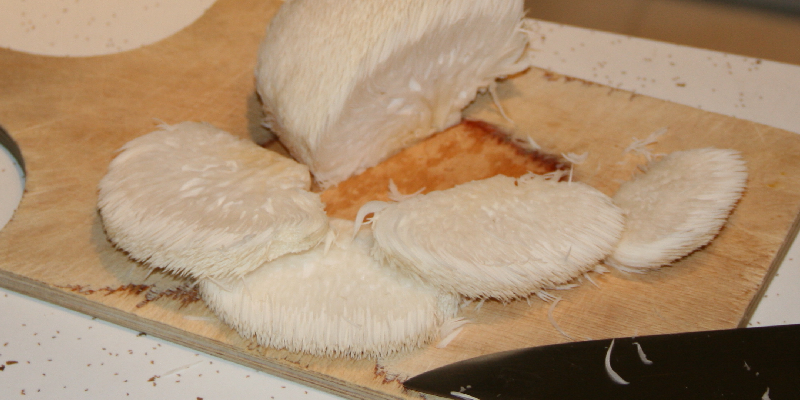
Working With Fresh Lion’s Mane Mushroom
Storing, cleaning, and cooking lion’s mane mushrooms isn’t complicated — but you do want to take a few basic steps to ensure that your delicacy cooks nicely and tastes great.
Storing Lion’s Mane Mushroom
When you bring fresh mushrooms home from the store, don’t clean them. Instead, place the unwashed mushrooms in a brown paper bag and put the bag in the refrigerator. The fresh mushrooms are naturally moist and spongy, so washing them and then storing them will only add to the moisture content and speed up molding.
Don’t put the bag in the vegetable, or crisper, drawer of the refrigerator — the small, closed area is more humid than the open area of your refrigerator. Keeping the mushrooms in the large, open space with air flow slows down molding.
How to Clean Lion’s Mane Mushroom
You should always clean lion’s mane mushrooms before cooking — just before cooking, not well in advance. Cleaning lion’s mane mushroom is best accomplished using a mushroom brush — this type of brush is inexpensive and the bristles are very soft to avoid gouging or scraping off the mushroom skin.
After brushing, wipe the mushrooms with a dry paper towel to further clean the fungi. You want to avoid soaking mushrooms in water as that tends to make them soggy and more difficult to cook.
Cooking Lion’s Mane Mushroom
When it comes to cooking with lion’s mane mushroom, keep it simple — in fact that’s the key to cooking any type of mushroom.
A lion’s mane mushroom has strands, or spines, that hang down from its base, but the strands are usually fairly short and the bulk of the mushroom is a spongy base. That means the mushroom can be sliced into thin “steaks” that are perfect for sautéing or further chopping to add bits to other ingredients in a recipe. Before slicing, cut off what’s referred to as the foot of the mushroom — a small, short stalk-like part that the mushroom uses to attach itself to the tree it grew on.
Unless the mushroom is being used in a recipe where it’s mixed in with a batter before cooking (like the lion’s mane mushroom pancakes listed below), they’ll typically be cooked in a frying pan. In such cases it’s important to start the frying or sautéing in a dry pan. The goal is to first dry out the mushroom, and only then add oil or butter. That way the mushroom absorbs the flavors of the seasoned oil or butter without becoming water-logged and soggy from a high water content.
Cooking time for lion’s mane mushrooms it usually fairly short — typically just 3 to 4 minutes for each side, or about 6 to 8 minutes total if stirring (such as in a stir fry recipe).
When lion’s mane mushrooms are properly cooked they’ll have a tender, meaty texture.
Lion’s Mane Recipes
Including lion’s mane mushrooms in food dishes used to be considered quite an exotic thing to do, but lately the practice has become more popular and commonplace. There are countless recipes for lion’s mane mushrooms on the Internet — here we present a couple favorites.
Sauteed Lion’s Mane Mushroom Recipe
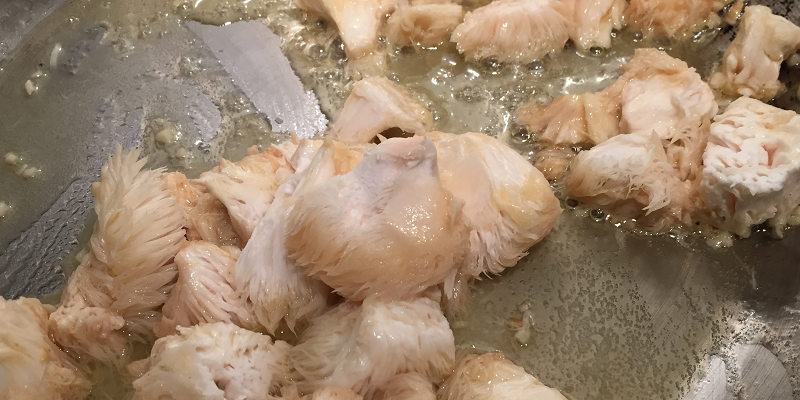
Sautéing lion’s mane mushrooms is fast, simple and results in a delicious seafood-like flavored snack or side dish. Be sure to thoroughly dry the mushrooms before cooking in butter or oil. There are no exact measurements in the ingredients list — simply season to taste.
Ingredients
- lion’s mane mushrooms, sliced 1/2-inch thick
- butter or olive oil
- minced garlic
- chopped parsley
- salt and pepper
Directions
- Heat a pan, without oil or butter, over medium heat
- Sauté the mushroom slices until the they release their moisture and begin to brown
- Remove the mushrooms from the pan and place on a plate
- Add your choice of butter or oil, and the garlic and parsley, to the pan and heat for a few minutes
- Return the mushrooms back into the pan
- Add salt and pepper to taste
- Sauté the lion’s mane mushrooms, stirring occassionally, until golden brown (about 4 to 5 minutes)
Lion’s Mane Mushroom Pancakes Recipe
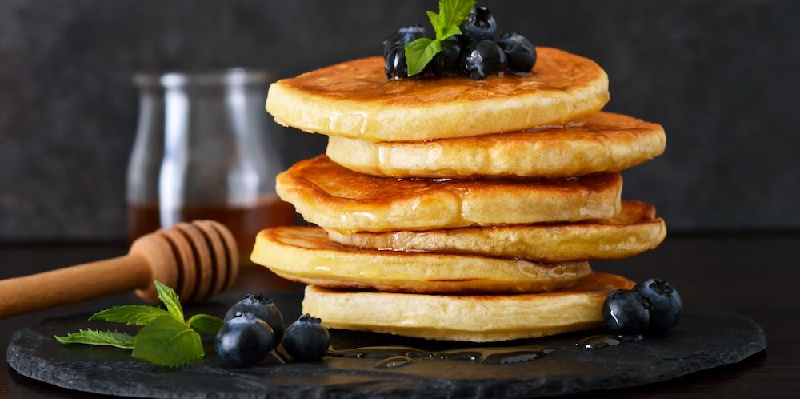
Everyone loves pancakes, and now you can improve your brain while enjoying a favorite breakfast meal.
Ingredients
- 2 large or extra large eggs
- 1 1/2 cups of milk or almond milk
- 1 1/4 cups of flour
- 1/4 cup melted butter
- 1 cup of lion’s mane mushroom, chopped
Directions
- Whisk together eggs and milk in large bowl
- Add butter, flour, and chopped lion’s mane mushrooms and stir until smooth
- Add pat of butter to a pan on medium-high heat, then pour 1/2 cup of mix to the pan
- Flip when bubbles appear, pancake is done when both sides are golden brown


